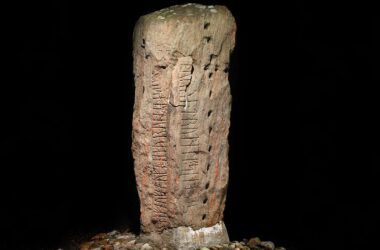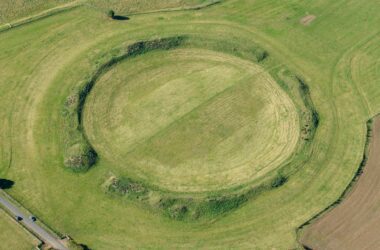Put one of the forks in a stick in the sand. As shown above on a South African beach by Charles Helm of the African Centre for Coastal Palaeoscience in Gqeberha, if you turn it like a compass, you can etch a perfect circle.
Our forebears clearly felt the same compulsion to express themselves visually at least 136,000 years ago when they drew on the sand. Above, you can see a piece of sandstone from Garden Route National Park that Helm discovered in 2018 and found to be a perfect circle with a hollow in the centre. Rock art and the world’s oldest footprint, estimated to be over 150,000 years old (shown below), have made this region famous as a site where early Homo sapiens left their mark.
The slab was formerly the sandy top of a coastal flat that turned to rock. Grooves, crosshatches, parallel lines, and a perfect triangle (seen below) are just some of the human-made designs that Helm has found in the same outcrop. Coloured pictures show how profound the impressions are.
After ruling out the wind, water, non-human creatures, and flora, Helm was left with the conclusion that they were likely human-made but likely didn’t mean very lot. Helm says, “I’d like to think it’s kids just messing around.”
After cave paintings (pictographs), rock engravings (petroglyphs), images carved on trees (dendroglyphs), and arrangements of rocks or soil (geoglyphs), he argues that these sand drawings should be classified as a fifth category of palaeoart. To honour ammos, the Greek word for sand, he suggests calling these hieroglyphics by that name.
FAQs
- What are ancient sand drawings?
- Ancient sand drawings are intricate patterns and shapes etched into coastal sand flats by our ancestors. These drawings are believed to be a form of artistic expression and date back at least 136,000 years.
- What is the significance of the discovery of these sand drawings?
- The discovery sheds light on the creative impulses and activities of our ancient ancestors. It provides insights into early human history and the ways in which humans expressed themselves through art.
- What distinguishes sand drawings from other forms of palaeoart?
- Sand drawings represent a fifth type of palaeoart, distinct from cave paintings, rock engravings, tree carvings, and arrangements of rocks or earth. They are known as ammoglyphs and were created on coastal sand flats.
- What is the proposed origin of the term “ammoglyphs”?
- The term “ammoglyphs” is derived from the Greek word “ammos,” meaning sand. It was coined to describe these ancient sand drawings and acknowledge them as a unique form of artistic expression.
- Why do researchers believe these sand drawings were made intentionally by people?
- Natural causes such as wind, water, animals, and vegetation were ruled out as potential creators of these intricate patterns. The intentional nature of these drawings is suggested by their complexity and arrangement.







